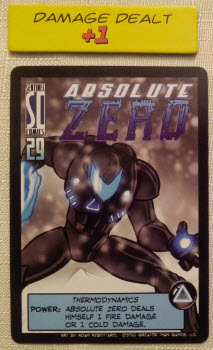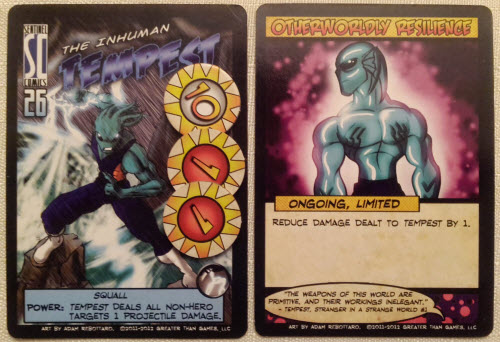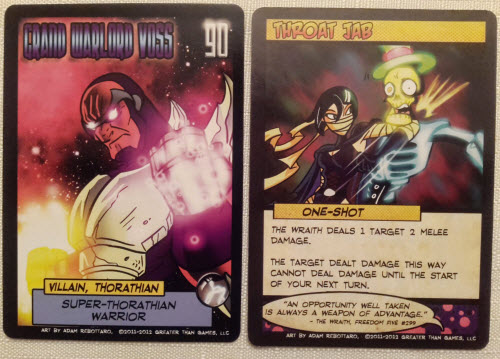Note: This review pertains to the Enhanced (Second) Edition of Sentinels of the Multiverse
You land upon the hard stone with an audible thud. Immediately you try to regain balance, but your body has other ideas. You find yourself on your knees, reflexively expelling blood, spittle, and possibly a tooth. Instantly, air comes flooding back into your chest as you try to breathe. The burning is excruciating, your lungs slowly reinflating, but you don’t care.
Your mind races as you try get back into the fight, but after multiple blows, your system has finally betrayed you. With monumental effort you prop yourself upright. Senses slowly snapping back into place, you can tell that more than few ribs are broken, only eye is working, and there’s a low buzzing sound that you can’t quite place.
“…THAT, my dear, is why you shall never defeat me, for I am Baron Blade…”
Wait. You found the buzzing after all.
“…unending dominion over…”
You couldn’t help it. Knowing the tremendous pain it would inflict, you begin to laugh.
“And WHAT is so funny? You are defeated, and you will die by my hand! You didn’t see that coming, did you Visionary?”
“No”, you manage to croak out, “But to be fair, you didn’t see Haka coming either.” You smile mildly as a large shadow looms over Baron Blade. Sinking into unconsciousness, you hear faint echoes of the Baron’s cries and his lab being torn asunder. Whatever the cost proves to be, you can rest knowing that you were victorious.
The Premise
Dangerous villains are on the loose, and they’re threatening to destroy everything good and right with the world. To stop them, players take on the roles of various super-powered heroes who must work together as a team to defeat their archenemy.
The Rules
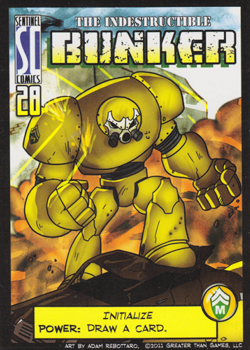
Meet Bunker. He smashes things.
Sentinels of the Multiverse is a fixed-deck card game, with players working as superhero team. To begin this Co-Op game, each player selects one of ten available heroes and takes that character’s deck. Each hero possesses different powers, styles, and health totals to utilize throughout the course of the game.
Villains also come with their own unique decks, behaviors, and starting conditions, and players choose which of four enemies they wish to face. What’s more, players must not only grapple with the effects of whom they are fighting but where. This is done by selecting from one of four Environment decks, depicting the location the game’s battle takes place at and the dangers it poses to the heroes.
Sentinels is played over a series of short rounds, broken down into three phases. First, the villain take their turn. This consists of dealing with the effects of existing Villain cards in play, drawing and resolving the top card of the Villain deck, and dishing out damage to players. Villain cards contain the various tools, traps, and minions villains have at their disposal as they’re trying to undermine the forces of good.
Then players each take their turns. First, they handle any upkeep costs of cards in their area. Then they may play a card. Some hero cards will be one-time use, while others such as Equipment and Ongoing cards stay out. Next, a player may choose and activate one Power ability from among the cards they have in play. Power abilities have wide-ranging effects, although most of them revolve around doing damage.
Damage in Sentinels of the Multiverse is straightforward: reduce the enemy’s hit points to zero. Heroes and villains have hit point values on their character cards, as do many other Villain and Environment cards. Damage comes in many subtypes (such as melee, cold, or toxic), but it is all handled the same way. When players deal damage, they may assign it to any legal target. When a Device, Environment, Minion, etc. reaches zero HP, they are discarded. If a player reaches zero, however, they die. (Their spirit lives on in these cases, and players are still provided with limited options they can make in subsequent rounds.)
Many items and effects modify how damage behaves in Sentinels of the Multiverse, and the game provides a series of sturdy tokens to keep track of these changes. The game also comes with a bunch of damage tokens so that players can count up (or count down) health totals, though other items such as dice work too.
After playing their Power ability, the player draws a card and ends their turn. After all players have taken their turns, the Environment phase occurs. The Environment phase works almost identically to the Villain phase, with players resolving any card effects from previous rounds and then revealing a new card.
Rounds continue in this manner until either all players are dead, or the villain is. If players defeat the villain, the forces of good will have triumphed over their insidious foe, and the heroes can enjoy a well-earned respite from their exhausting and challenging task. Justice has been done.
If all players die, however, then everyone collectively loses, expiring in a vain attempt at stopping the ambitions of a clearly superior being.
Saturday Morning Adventures
From the very first page of the rules (which appears like a comic book), Sentinels of the Multiverse radiates flavor. The entire game revolves around its comic book themed universe, and hallmarks of it are everywhere. The heroes and villains of the game all have very comic-esque powers, and everyone has a distinctly different flair to them. Whether you’re portraying the stalwart leader, the hulking brute, or the angry arbiter of vengeance, every character feels like they belong in this world, and every game session feels like another episode in a long-running series. (The rules even provides character backstories.) All of this is reinforced by the game’s artwork. Done in a universal style, each piece of artwork – depicted in the form of single comic panels – visually binds the game together even further.
Thus, when playing as the heroes, you get a real impression that you are that hero. Your deck is full of unique cards depicting your character’s traits and abilities, as well as entertaining flavor text. Playing as The Wraith comes off very different than playing as Bunker, for instance. Truly, the degree of thematic integration in Sentinels of the Multiverse is impressive, and Immersionists who can appreciate this original superhero universe will be more than pleased stepping into any of the hero roles.
The Scales Of Justice
The other area of note is how Sentinels handles game balance. Balance is an incredibly important factor when designing a game. This is doubly true for co-op games, since the game is acting as your opponent, and players rely on the challenge to remain invested. If that challenge is too easy, people’s interest dissipates. Make it too hard, and players will become frustrated and stop playing entirely.
The hardest balancing factor is the number of players. Some games become harder with more people playing; others become easier. With Sentinels of the Multiverse, that choice is up to you. Every game will have between three and five heroes, a villain, and an environment. Beyond that, you control your own fate, making the game incredibly flexible. Do you fight the alien overlord, or the evil genius? Would you prefer to duke it out on Mars, or in the ruins of Atlantis?
The heroes’ power scale is also adjustable. You could simply select the hero you want, or you could strive for a diverse team. You can purposefully include or leave out the hero who is the “nemesis” of the villain – a fun but underused mechanic whereby that hero and the villain deal each other extra damage. And, yes, the usefulness of some heroes increases or decreases depending on player size (we’re looking at you, Legacy).
There is so much balance to Sentinels, in fact, that the game acknowledges this and offers an advanced unbalanced option for the villains. You know, in case you need even larger challenges.
The most impressive part of this balance, though, is how Sentinels of the Multiverse handles utility and defensive characters. Team-based games often have a hard time making characters fun who aren’t on the front lines hurling damage and blocking blows. (Also known as the plight of the healer classes.) While essential to the success of the team, they’re often not nearly as exciting to play.
Sentinels of the Multiverse does not have this problem. Every hero has the capability of dealing damage, so everyone is able to throw a punch if needed, but not everyone is designed to be a heavy hitter. Several heroes actually favor supporting roles, boosting the powers of their teammates or stymieing the enemy. However, because these actions are just as pivotal to your success as hurling damage, you never have that feeling you aren’t an essential part of the team or that you’re relegated to a second-class status. Everyone has a role to play here, and everyone is needed to win.
All Of The Adventure, None Of The Spandex
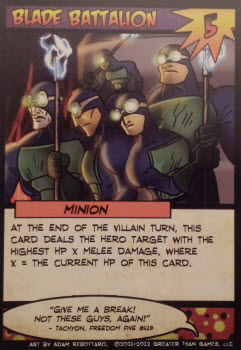
Hooray expendable minions.
Every playthrough of Sentinels of the Multiverse is a new adventure, with its own makeup of heroes villains, and more. Throughout it all the game remains compelling, as players must figure out how to defeat the bad guys and save the day.
Because each character approaches that goal slightly differently than one another, there is, ideally, a character to suit everyone’s taste. Some characters focus on gadgets and tools to boost their powers; those heroes will resonate with Architects. Others are less direct, making you work to unlock their inner firepower, which appeals to Tacticians. Still others lack complexity (or subtlety) and just prefer to smash things as frequently as possible.
None of this matters if co-ops don’t resonate with you, as tends to happen with Daredevils. On the one hand, Sentinels of the Multiverse certainly has its fair share of random scenarios (such as fighting a sentient robot on an island out of Jurassic Park), and you never know what will be revealed each round. On the other hand, between being limited to one card and one Power per turn, it forces you to stay focused on the central task. Daredevils will certainly be willing to try this game, which is further than they get for most co-ops, but most will likely feel handicapped.
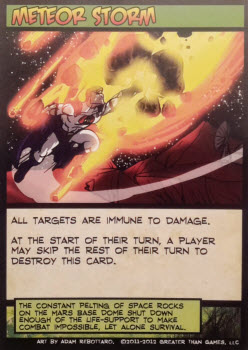
“Incoming Meteor Storm. Please pause hostilities. Thank you!”
By contrast, this game will have the opposite impact on Strikers. Co-op games are always a tricky genre for this archetype, but Sentinels should prove appealing. For all of its moving parts, Sentinels of the Multiverse has a singular task: do enough damage to defeat the villain and you’ll win. They’ll enjoy the unencumbered nature of that goal here – so long as they’re comfortable sharing a win.
Those same moving parts, however, do come at a cost. For one, they add a bit of fiddliness when trying to calculate things such power bonuses, and there is some occasional ambiguity on card interactions. Sentinels of the Multiverse is otherwise a fairly easy game to learn – enough so to even entice the interest of Socializers – but most of them will lose enthuiasm due to the moderate amount of board state monitoring required.
The Takeaway
With all of the interchangeable aspects of the game, Sentinels of the Multiverse remains remarkably well-rounded. Every time you play it’s as if you’re stepping into the middle of an action-packed comic episode. Indeed, Sentinels puts a remarkable amount of detail into crafting an entirely original comic universe, and yet it presents it a way that is incredibly flavorful without being overwhelming or pulls away from the actual gameplay. It’s both engaging and challenging, forcing heroes to make tough choices as a team. There can be confusion with some of the game tracking that needs to be done, but this is a fairly minor issue. (Plus, what would an epic hero battle be if there weren’t just a little bit of chaos?) Overall, Sentinels of the Multiverse makes for thematically rich co-op game with a high replay value and a real sense of purpose, worthy of the attention of heroes everywhere.
Sentinels of the Multiverse is a product of Greater Than Games.
Cardboard Republic Snapshot Scoring (Based on scale of 5):
Artwork: 5
Rules Clarity: 4.5
Replay Value: 5
Physical Quality: 4.5
Overall Score: 5


